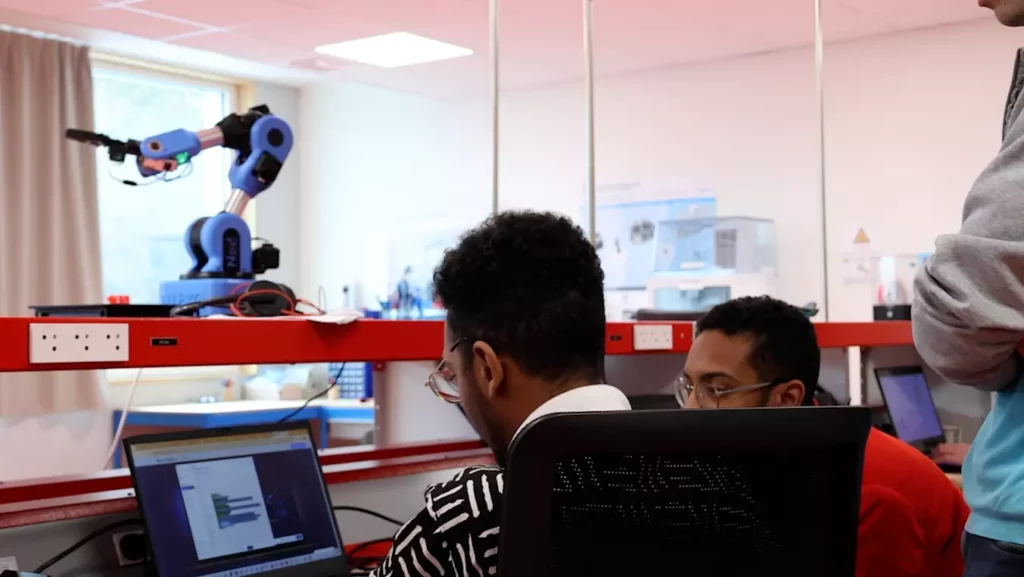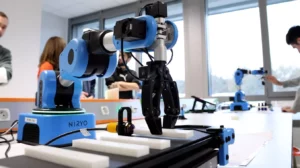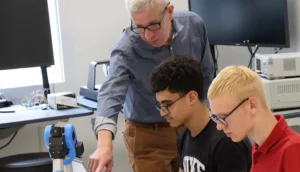New deep-tech technologies such as ChatGPT, Character.ai, Midjourney, Bard or Capcut…, fascinate billions of users worldwide. A veritable revolution of the modern age, they are used by professionals and private individuals alike. Artificial intelligences have suddenly invaded our daily lives to the point where learning them is a matter of course. As such, robotics can be used to teach AI. Discover how robotics and AI complement each other.
The year 2022 ended with the advent of a new era: that of artificial intelligence. Since the introduction of the ChatGPT language model, Artificial Intelligence has reached a major milestone in the sphere of digital technologies. Language models are programmed to learn, find solutions and make decisions in the same way as humans. In the field of robotics, AI is a catalyst for productivity. Robotics powered by Artificial Intelligence (robotic AI) has improved the performance of both domestic and industrial robots.
The reverse system (AI robotics) is also possible, in that robotics can help in the learning of artificial intelligence. Robot-IA interactions can enrich machine learning models, opening up new possibilities in AI research. For example, learning AI using a 6-axis robotic arm can be ideal, whatever the level of the person wishing to improve their skills.
AI: a system that works like humans and animals
Artificial intelligence is not immune to error. As a result, it requires regular adjustments to respond perfectly to its user’s requests. As such, AI must learn every day.
Like humans and animals, AI’s learning process is based on mistakes. For example, animals are able to recognize when they have made a mistake. Then, to avoid repeating the same mistake, they are able to reflect and act differently. It’s exactly the same with artificial intelligence.
AI learns through delayed feedback. This process enables the machine to better adapt its responses to user requests.
Given this capability, AI can be transformed into a truly powerful tool, capable of making well-considered decisions on its own. To achieve this, it can rely on various learning methods, including what is known as reinforcement learning.
Understanding reinforcement learning
As mentioned earlier, reinforcement learning (RL) is a method of teaching AI to make decisions on its own. It therefore differs from the other two AI learning methods, namely supervised and unsupervised learning.
With AR, AI must learn on its own through interaction with its environment. In other words, it acquires all the information it needs from its environment and then integrates it into its memory. After repeated practice, it can refine its learning. To enable the AI to assimilate lessons, the technique relies on a system of rewards and punishments.
This type of approach is applied in a variety of fields. Social networking AIs, for example, study users’ behavior and information with a view to proposing appropriate content. Reward in this case concerns user actions such as likes and shares. Another example is AR, which enables robots to pick up objects automatically, without human assistance to guide them. Many other fields of application can benefit from AI reinforcement learning.
Robotics could revolutionize AI learning
Reinforcement-based AI learning remains practical for solving complex problems through direct interaction with the environment. In this sense, robotics is proving to be an interesting alternative. The robot is able to provide guided instruction, which in turn enables the AI to retain more precise information, and thus limit its errors.
Today’s tech giants are working on humanoid robots capable of naturally reproducing complex tasks. This is the case, for example, of the technicians at Columbia Engineering. They use haptic feedback solutions to tame the robot.
In practice, an operator performs tasks that the robot must imitate subtly at first, thanks to a connection with the operator via joysticks. The robot’s AI, for its part, records the various actions performed by the joysticks thanks to its interaction with the operator, in order to reproduce them in the future.
There are also many simple exercises to link theory and practice, such as:
- reproducing the movements of a human arm by a robot using AI,
- translating the programming language of a robot to test it with different AI algorithms, and many other subjects.
Robotics and AI: prospects for innovative research
If AI can be used to optimize robotic performance, to what extent is it possible to train with AI via a robotic arm? Although not yet documented, knowledge transfer and data collection offer interesting prospects. Here are a few avenues that you, as a researcher, can explore.
Developing AI robotics for skills transfer
At one American university, a robot was able to perform a task based on the knowledge of another robot located at another university. The PR2 robot knew how to move mugs and arrange them in a specific way, a task for which it was programmed. By registering its knowledge on the RoboBrain platform, it enabled Baxter, another robot, to access it. Baxter picked up the knowledge and was able to move the objects in the same way.
The study highlights the fact that a robot trained to perform specific tasks can then transfer its “know-how” to another robot. By training robots to perform specific tasks, researchers and developers could enhance the capabilities of AI systems.
Using robotics for data collection
The use of robotics can also simplify data collection tasks. Autonomous Mobile Robots (AMR) are examples of this technology. Equipped with cameras and sensors, these robots can record image, video or physical measurements of objects in a given environment. This data can then be used to train an AI.
As a reminder, AI is programmed to reason like humans. To enable AIs to evolve and improve machine learning skills, researchers could also call on robots. The idea would be to program them to interact with human beings and record reactions during their interactions. Once transferred to AI, the data on the latter can help to understand human behavior and improve machine learning models.
Build the future of AI with Ned2: our 6-axis robotic arm
In the context of AI learning, the Ned2 6-axis robotic arm we offer proves to be a very complete tool. Thanks to its robust design and numerous accessories, Ned2 provides an ideal experience for carrying out exercises based on artificial intelligence and the robot. The latter enables students to interact directly with a physical system. Our robotic arm opens up new perspectives for learning and understanding the fundamentals of AI. By combining the power of robotics with artificial intelligence, Niryo paves the way for comprehensive learning in these fields.






